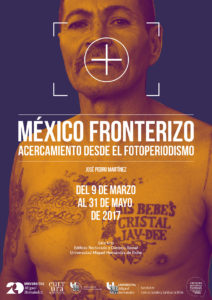PHOTOJOURNALIST JOSÉ PEDRO MARTÍNEZ EXHIBITS HIS WORK, MÉXICO FRONTERIZO, AT THE UMH
 México Fronterizo: Acercamiento desde el fotoperiodismo (Frontier Mexico: A Photojournalistic Approach) is the name given to the photographic collection by journalist José Pedro Martínez, and comprised of two parts: La ciudad de los deportados (City of the Deported) and Orígenes (Origins). The first collection features the two migratory flows that converge on the Mexican/US border through photographs of those deported, migrants in transit, and scenes of everyday life in city stopping points along the way, such as Tijuana. Its second part, the series on Guerrero, reflects the social context from many of the migrant protagonists in the photographs, according to the photojournalist.
México Fronterizo: Acercamiento desde el fotoperiodismo (Frontier Mexico: A Photojournalistic Approach) is the name given to the photographic collection by journalist José Pedro Martínez, and comprised of two parts: La ciudad de los deportados (City of the Deported) and Orígenes (Origins). The first collection features the two migratory flows that converge on the Mexican/US border through photographs of those deported, migrants in transit, and scenes of everyday life in city stopping points along the way, such as Tijuana. Its second part, the series on Guerrero, reflects the social context from many of the migrant protagonists in the photographs, according to the photojournalist.
México Fronterizo is a selection of the documentary work by the photojournalist, who for years has been working freelance along the Mexican border, and has been published in prominent media, including Newsweek, eldiario.es, The Guardian, and Al Jazeera. Martínez presents the exhibition as a vehicle to “tell what is occurring in this part of the world with the human rights to thousands of migrant individuals,” and he thinks that its university showing can “motivate other students to put an effort forth and gain a passion to become journalists.”
José Pedro Martínez holds a UMH Bachelor’s in Journalism degree. He went to Mérida, Mexico, in 2011 with a grant from the UMH Destino Exchange program. A few months later, he moved to the north of that country and began his training at a local television channel. From that moment onward, with the exception of the past academic year, when he returned to Spain to enroll in this university’s Master’s in Innovation in Journalism program, Martínez has lived and worked along the Mexican border. Currently, he collaborates closely with the Los Ángeles Press, a Mexican not-for-profit media organization specializing in politics, democracy, and human rights.
.
The journalist also freelances, reporting in international media on the complicated situation at the border, which is reflected in the exhibition on display at the UMH: “Over the past 10 years, deportations have increased, and the cities there have transformed very quickly. We are talking about three million people who had passed through this border and were kicked out of the United States, to which we must add the various flows of hundreds of thousands of migrants of diverse origins who themselves are moving north,” explains Martínez. “The quantity of Central Americans fleeing violence has grown alarmingly over the last three years; many of them are adolescents, and there are even small children. It is a very complex situation to which diverse cultural, political, and social problems come together, creating what gives name to this region between two countries: the border.”
The exhibition, organized by the Vice Rectorate for Culture and University Extension, in collaboration with the Vice Rectorate for International Relations, the Faculty of Social and Legal Sciences, and the Department of Social and Human Sciences, was inaugurated this morning by the UMH Rector, Jesús Pastor Ciurana. The collection of photographs will be on display until May 31 in the Gray Room of the Rectorado & Consejo Social Building on the Elche Campus.




